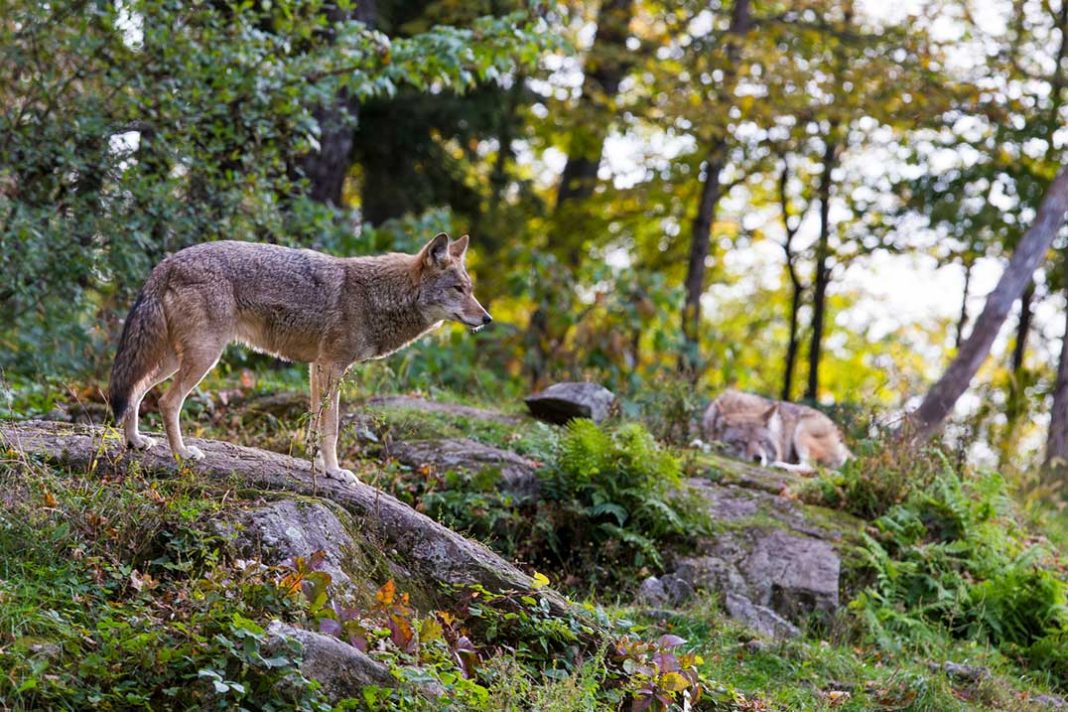NORTHEAST TOWN – At a recent meeting of Northeast Town council, George Hagen, president of the Manitoulin Trappers Council, suggested council adopt a coyote compensation program for those trappers, hunters and farmers contributing their efforts to control the coyote population in the Northeast Town.
He explained that the eastern coyote ranges in weight from between 30 and 60 pounds and can breed every 10 months.
Mr. Hagen said he’s had talks with livestock evaluators who say that more and more instances of livestock loss are the result of predators. He said he also spoke with one farmer from the Northeast Town who lost six calves last year because of predators and was only compensated for four of those losses. Mr. Hagen reminded council that coyotes also feed on deer, which are valuable to Manitoulin’s hunting tourism industry.
Currently Central Manitoulin, Burpee and Mills, Assiginack and Gordon/Barrie Island all offer coyote compensation programs, all of which are similar in that there is a $2,000 cap per year at $50 per carcass.
“It’s not to eradicate, but to control their numbers,” Mr. Hagen stressed.
Councillor Laurie Cook expressed her worry that other animals, such as dogs, might become secondary losses should they get caught in coyote snares. Mr. Hagen explained that he always asks the landowners (traps can only be set with landowner permission and by a licenced trapper) if they have animals. If they do, Mr. Hagen asks the landowner to tie them up or keep them inside. While there’s never a guarantee a dog won’t be snared, Mr. Hagen said he has never caught one in his 43 years of trapping.
The topic was brought up for discussion at the following meeting, on January 26.
CAO Dave Williamson reminded council that the municipality used to have a coyote and wolf bounty where an animal would be brought in to the municipal office, the ear was snipped and a cheque was handed over.
Mr. Williamson said the bylaw would clearly state that the coyote must have been taken from the municipality with permission from the landowner and proof of licence. The carcass would now be brought to the public works garage where the ear would be snipped (this ensures that the coyote can’t be brought in for compensation purposes again), paperwork filled out and a cheque issued. No compensation above $2,000 annually would be issued.
“The municipality is in the business of supporting the agricultural community in this way,” the CAO added, noting that additional costs to the municipality would be nominal and suggested, if council wished, it could be done on a trial basis.
Councillor Michael Erskine said he felt the wording on payment needed clearing up to ensure clarity that it is a cap of $2,000 per year, not $2,000 per year per trapper. Councillor Erskine also suggested allocating the up to $2,000 to the rural wards in the municipality, meaning the tax burden this represents would be borne by rural taxpayers.
Councillor Bill Koehler asked if a farmer or landowner could trap their own coyotes. This could also be added to the bylaw, the CAO responded.
Councillor Bruce Wood, a Ward 4 beef farmer, took exception to Councillor Erskine’s suggestion on the allocation of funds. “Right now, we’re paying $22,000 to take care of Ward 2’s dogs and cats.” (Ward 2 is in Little Current.)
He also explained that a farmer is not just losing a calf following a predator kill but also the cow because of rebreeding purposes, not to mention the expense of feeding a cow that no longer has offspring.
Councillor Al Boyd asked what happened to the previous bylaw and if there were many complaints.
Mr. Williamson explained that the wolf bounty was in place from 2005-2006 when, a short time later, the province’s wildlife compensation program came into effect.
Councillor Cook said she did a lot of research on coyote trapping and questioned its effectiveness as a result, stating that science shows that coyotes and wolves are not deterred by such programs.
Councillor Cook wondered how many other species would be killed because of the program and what effect it would have on the ecosystem. She also wondered if there was an appetite for this in the community and suggested tabling the motion until public input is sought.
Councillor Wood said he’s been hearing a lot of complaints about the deer herds being affected, adding that once the deer are effected, predators will set their sights on livestock.
“I’m an avid deer hunter and almost exclusively hunt Ward 1,” said Councillor Jim Ferguson. “In the past three years, the population has either been decimated or driven out by the Algonquin hybrid. I will back this 1,000 percent all day, every day. Where do I sign?”
As Ward 1 councillor, Councillor Cook said she disagreed with Councillor Ferguson and noted that on the Bay of Islands side, deer herds are exploding in population.
Councillor Dawn Orr said she heard a recent horror story from a farmer as well as anecdotal evidence from the hunters who hunt her farm each year and agrees with the program.
Councillor Erskine said he would rescind his comment on allocating the program funds to just Wards 3 and 4.
Councillor Cook made a motion to defer the motion to the following meeting of council, seconded by Councillor Erskine. The vote was tied and defeated by the mayor.
A second motion was then made to enact the program on a one-year trial basis. In another recorded vote Councillors Al Boyd and Laurie Cook voted in favour of the trial while Councillors Erskine, Ferguson, Koehler, Orr, Wood and Mayor MacNevin voted against the motion. The motion was defeated.
A third motion was then brought forward to enact the bylaw. In a recorded vote, all but Councillor Cook voted in favour and the motion passed.





